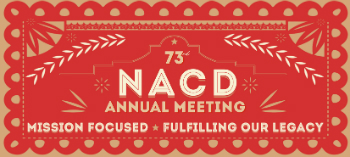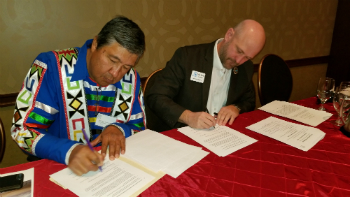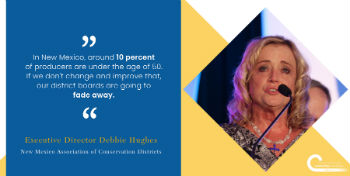NACD APPLAUDS USDA’S NRCS CHIEF APPOINTMENT
On Monday, Dec. 3, USDA Secretary Sonny Perdue appointed Matthew Lohr to serve as Chief of the department’s Natural Resources Conservation Service (NRCS).
“NACD welcomes this long anticipated announcement,” NACD President Brent Van Dyke said. “In addition to being raised on a farm, Matt Lohr has proven his commitment to agriculture and conservation through his nearly 30 years in leadership capacities. NRCS is a crucial partner in the federal, state and local government conservation partnership, and I applaud USDA for its diligence in appointing a strong leader.”
Lohr was raised on a farm in Virginia’s Shenandoah Valley, and as a fifth-generation farmer, he continues his family’s legacy with his wife Beth and their six children through their operation, Valley Pike Farm, Inc. In 2006, Lohr was elected to the Virginia House of Delegates and later served the state as the Commissioner of Agriculture and Consumer Services from 2010 to 2013. Additionally, as a teenager, Lohr was elected vice president to lead the national FFA organization, a student organization of over 400,000 members.
“As a fellow Virginian, I am confident Lohr has the experience, passion and work ethic to lead NRCS and advance voluntary, locally-led conservation efforts in partnership with the nation’s 3,000 conservation districts,” NACD CEO Jeremy Peters said. “His extensive career as both a policymaker and a farmer gives him insight into effective program delivery and customer service working with landowners to implement conservation programs, to protect natural resources and to build sustainable conservation solutions.”
Lohr will take over for Leonard Jordan, who has been serving NRCS as the acting chief since 2017. Read NACD’s statement on Lohr’s appointment on the national association’s website.

NACD EXTENDS AUCTION DONATION, EXHIBITOR DEADLINE
NACD’s 2019 Annual Meeting is fast approaching, with the deadline to register at discounted, early-bird rates coming up on Friday, Dec. 14, 2018.
NACD has extended the deadline to commit an item to the 2019 Annual Meeting Live Auction to Friday, Dec. 14, to provide districts and state associations with the opportunity to submit an item representing their state. Fill out this short, online donation form to donate an item. Popular items include locally-made wares, jewelry, leather goods, produce and art.

Visit the 2019 NACD Live Auction webpage to browse the current selection, including turquoise jewelry from New Mexico, Black Hills Gold from South Dakota, an engraved belt buckle from Montana (pictured), handbags, confections, customizable chinks and a handmade Amish quilt.
NACD also extended the deadline for sponsors and exhibitors to Friday, Dec. 14, 2018. Gain recognition for your business, agency and organization and introduce your programs, products and services to conservation leaders in NACD’s 2019 Annual Meeting Conservation Expo. Read more about exhibitor and sponsor opportunities on NACD’s Conservation Expo webpage.
NACD ATTENDS STATE MEETINGS IN CALIFORNIA, COLORADO
Last week, NACD leaders and staff represented the national association in the great states of California and Colorado. On Nov. 14-17, 2018, NACD President-elect Tim Palmer addressed the California Association of Resource Conservation Districts (CARCD) at their 73rd annual meeting in San Diego, Calif. With the theme “Celebrating Resilient Landscapes and Adaptive Communities,” members, district staff and partners had the opportunity to hear about the effects of the wildfires in the northern part of the state. Meeting-goers also were provided with a farm bill update from incoming NACD Pacific Region Executive Board Member Tom Wehri. Palmer, pictured below right with NRCS liaison to resource conservation districts Gayle Barry and NRCS state conservationist Carlos Suarez, addressed meeting attendees and described NACD's ongoing work to improve on-the-ground district capacity.

On Nov. 29, 2018, NACD President Brent Van Dyke and NACD Western Issues Specialist Jeff Burwell attended the Colorado Association of Conservation Districts (CACD) 74th Annual Meeting in Loveland, Colo. Van Dyke delivered the keynote address followed by addresses from the Colorado Department of Agriculture Commissioner Don Brown, NRCS State Conservationist Clint Evans and Colorado Soil Conservation Board program manager Cindy Lair. The conference included two days of meetings, speakers and breakout sessions, which provided the opportunity for productive collaboration between conservation district managers, staff and supervisors, partners and producers. Video footage of the meeting's speakers is available online, courtesy of the BARN.
NACD SIGNS MOA WITH INCA
From Nov. 26-30, the National Tribal Conservation Districts and USDA Tribal Conference was held in Catoosa, Okla. Hosted by the Indian Nations Conservation Alliance (INCA), the meeting featured NRCS Acting Chief Leonard Jordan and Oklahoma State Conservationist Gary O'Neill as speakers. Meeting-goers also learned from INCA staff about the process of forming a tribal conservation district, as well as NRCS’ work on regional tribal conservation advisory councils.

NACD Second Vice President Michael Crowder and South Central Region Representative Keith Owen attended the conference. Crowder, who also serves as chair of NACD’s Tribal Outreach and Partnership Resource Policy Group (RPG), presented on the national association’s partnership efforts with tribal conservation districts. During the meeting, a memorandum of agreement (MOA) was signed (pictured) between INCA, NACD, the National Conservation District Employees Association (NCDEA) and the National Association of State Conservation Agencies (NASCA).

The Eriksen family farm, Lehnskov Inc., is a 3,000-acre operation spanning both the Pine Creek Conservation District and the Palouse Rock Lake Conservation District in Whitman County in eastern Washington. Tracy (pictured) and his wife April farm the land with their son Kye and his wife Christy Eriksen. Kye is the fourth generation of Eriksens to farm the land, starting back in 1907 with his great grandfather, a Danish immigrant.

The farm sits on 99 percent highly erodible land, with very little level land and slopes up to 45 percent. In the 1970s, Tracy Eriksen came to the realization that his generation would be the last to farm his land if they didn’t change the way they farm and stop the resulting erosion. This was one of the biggest reasons Tracy transitioned his operation first to conservation tillage and then ultimately to 100 percent no-till. Eriksen reflected the seasonal norms of his youth – deep ditches and gullies cut throughout the fields after a snow melt, putting planks up just to get the combine and tractors across the ditches, and the less-obvious sheet erosion due to the strong winds. To that end, he feels making the switch in his operation has pretty much eliminated the threat of erosion.
No-tilling is part of a bigger strategy in his operation, however. The Eriksens farm is in an area that receives between 15 – 20 inches of annual rainfall, so it is important to capture and protect the moisture on the land. Leaving behind as much crop residue as they can creates a dense mulch mat that protects the top layer of moisture from evaporation from the sun, and results in extending the protection of the moisture within the soil. Farming in such field conditions, however, requires special equipment. They’ve invested in a Shelbourne stripper header which leaves tall stubble from their wheat crop on the ground, and they’ve experimented with a variety of direct-seed drills that can work through such conditions. Such drills are designed to seed and fertilize a crop in the residue and root structure from the previous year’s crop, leaving the soil undisturbed.
The Eriksens are now exploring improving the biological health of their soil by experimenting with compost extracts, teas, cover crops and biological amendments. To read more about their operation and soil health management system, check out their NACD profile and follow Tracy’s blog “Farming the Palouse.” Interested in joining this dynamic network of NACD Soil Health Champions? Visit the NACD website or contact NACD North Central Region Representative Beth Mason.
UPCOMING U&C WEBINAR FOCUSES ON WATER QUALITY INITIATIVES
This month’s NACD Urban and Community (U&C) Conservation webinar is scheduled for Thurday, Dec. 20, from 12:00 p.m. – 1:00 p.m. EDT. The webinar will showcase several water quality initiatives in districts.
The Rockingham County Conservation District in New Hampshire installed demonstration permeable reactive barriers (PRB), a new passive technology used to control nitrogen with a formulation of wood chips, exchange media and sand or gravel to transform inorganic nitrogen to nitrogen gas. This technology can be used in conjunction with an existing or new septic system to prevent nitrogen migration to sensitive watershed areas.
In Wichita, Kan., sandy soils have been mined for commercial purposes, resulting in a sand pit that fills with groundwater. Stormwater drains into the resulting lake from residential lawns, parking lots, driveways and roads. The Sedgwick County Conservation District, along with partnering agencies, set up monitoring wells to determine whether pollutants carried by runoff into sand pits affect the quality of groundwater and to help identify appropriate best management practices to address this.
NACD’s U&C webinars are held on the third Thursday of each month and are sponsored by The Scotts Miracle-Gro Company in partnership with the NACD Urban and Community Resource Policy Group. There is no cost to participate, but space is limited. Registration will be accepted on a first-come, first-serve basis. To register, email NACD Senior Advisor Debra Bogar at deb-bogar@nacdnet.org with your name, title, district or business name, state and email address. Information to access the webinar will be sent by email.
NEW MEXICO LEADER ADVOCATES FOR NEXT GENERATION

Today, Debbie Hughes, executive director for the New Mexico Association of Conservation Districts, sent a letter applauding those who donated to the National Conservation Foundation (NCF)’s Next Generation Leadership Campaign on Giving Tuesday. Hughes challenged members to continue contributing to NCF and NACD’s efforts to recruit the next generation of leaders to provide the energy and stamina needed to advance conservation.
“We must continue to recruit the next generation and engage them so they feel empowered to share their voice,” Hughes said. “In New Mexico, we discovered around 10 percent of our producers are under the age of 50. If we don't change and improve that, our district boards are going to fade away.
“Young people are so crucial to the future of conservation districts,” Hughes said. “They have the drive and energy, but we have to make them feel like they are making a difference. Otherwise, they will go find another organization where they can feel empowered.”
|
|
|
|
|
Email Marketing By
|


|
|
|
|
|